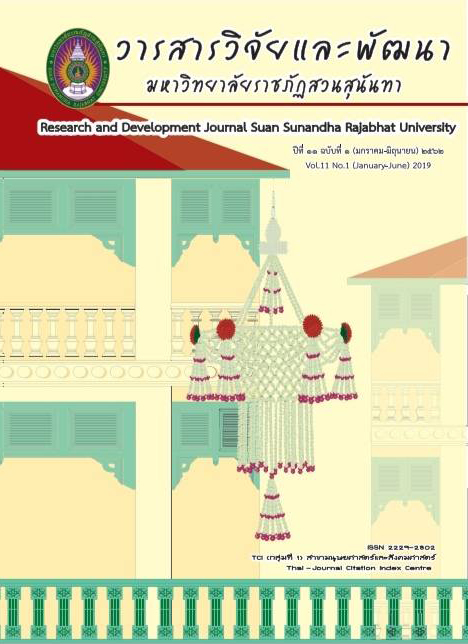การใช้การเรียนรู้เชิงผลิตภาพและโปรแกรม GSP สอนเรื่อง รูปเรขาคณิตสองมิติและการแปลงทางเรขาคณิต สำหรับนักเรียนชั้นมัธยมศึกษาปีที่ 1
DOI:
https://doi.org/10.53848/irdssru.v11i1.160509คำสำคัญ:
การเรียนรู้เชิงผลิตภาพ, โปรแกรม GSP, รูปเรขาคณิตสองมิติและการแปลงทางเรขาคณิตบทคัดย่อ
การวิจัยครั้งนี้มีวัตถุประสงค์เพื่อพัฒนาแผนการจัดการเรียนรู้ ศึกษาผลสัมฤทธิ์ทางการเรียนและศึกษาความคิดสร้างสรรค์เรื่อง รูปเรขาคณิตสองมิติและการแปลงทางเรขาคณิต โดยใช้การเรียนรู้เชิงผลิตภาพและโปรแกรม GSP โดยกลุ่มตัวอย่างเป็นนักเรียนชั้นมัธยมศึกษาปีที่ 1 จำนวน 30 คน กำลังศึกษาภาคเรียนที่ 1 ปีการศึกษา 2560 ของหลักสูตรห้องเรียนส่งเสริมความเป็นเลิศด้านวิทยาศาสตร์และคณิตศาสตร์จากโรงเรียนสาธิตมหาวิทยาลัยราชภัฎวไลยอลงกรณ์ ในพระบรมราชูปถัมภ์ การออกแบบการศึกษาในครั้งนี้เป็นงานวิจัยเชิงทดลองสำหรับแบบกลุ่มเดียว เครื่องมือที่ใช้ในการวิจัย ได้แก่ แผนการจัดการเรียนรู้ แบบทดสอบวัดผลสัมฤทธิ์ทางการเรียน และแบบทดสอบวัดความคิดสร้างสรรค์ แบบทดสอบวัดผลสัมฤทธิ์ทางการเรียนมีค่าความเชื่อมั่นเท่ากับ 0.79 ค่าความยากง่ายเท่ากับ 0.38-0.54 และค่าอำนาจจำแนกเท่ากับ 0.52-0.76 เวลาที่ใช้ในการทดลองครั้งนี้เท่ากับ 20 ชั่วโมง ผลการวิจัยพบว่า การใช้การเรียนรู้เชิงผลิตภาพและโปรแกรม GSP เป็นนวัตกรรมวิธีการจัดการเรียนรู้เรื่องรูปเรขาคณิตสองมิติและการแปลงทางเรขาคณิต จากการประเมินความรู้ของนักเรียนเรื่องรูปเรขาคณิตสองมิติและการแปลงทางเรขาคณิต นักเรียนมีคะแนนเฉลี่ยจากคะแนนรวม 100 คะแนนของแบบทดสอบก่อนเรียน (Pretest) และแบบทดสอบวัดผลสัมฤทธิ์ทางการเรียนเท่ากับ 47.90 และ 83.13 ตามลำดับ หลังจากการศึกษานักเรียนมีระดับความรู้หลังเรียนสูงกว่าก่อนเรียนอย่างมีนัยสำคัญทางสถิติที่ระดับ .05 นักเรียนมีพัฒนาการทางการเรียนเฉลี่ยเท่ากับร้อยละ 67.61 และแผนการจัดการเรียนรู้เรื่อง รูปเรขาคณิตสองมิติและการแปลงทางเรขาคณิต โดยใช้ มีประสิทธิภาพเท่ากับ 91.04/83.13 หลังการเรียนนักเรียนมีความคิดสร้างสรรค์สูงกว่าอย่างมีนัยสำคัญทางสถิติที่ระดับ .05
เอกสารอ้างอิง
Gardner, H. (2017). Five Minds for the Future. Boston: Harvard Business School Press.
Guilford J. P.. (1968). Intelligence, Creativity, and Their Educational Implications. Retrieved March 27, 2018, from http://journals.sagepub.com
Institute for the Promotion of Teaching Science and Technology. (2009). The Basic Education Core Curriculum B.E. 2551 (A.D. 2008) Mathematics. Bangkok: Ministry of Education.
Institute for the Promotion of Teaching Science and Technology. (2012). International Standard Science Classroom High school. Bangkok: Ministry of Education.
National Council of Teachers of Mathematics. (2011). Report from the 2011 NCTM Annual Meeting. Retrieved March 27, 2018, from http://www.dynamicgeometry.com/General_Resources/User_Groups/NCTM_2011.html
Panmani A.. (2014). Teacher: Creative Personality. Journal of Guidance and Educational Psychology, Vol. 2 (No. 3-4), 25-29.
Pattarasat K.. (2013). Creativity Essentials for 21st Century Education. Retrieved March 27, 2018, from http://www.prachachat.net
Teenakul S.. (2009). Influence of Calculator on Mathematics Achievement and Attitudes in Mathayom Suksa Udonthani Women's School. Retrieved March 27, 2018, from http://www.thailis.or.th/tdc
Torrance, E. P.. (1965). Rewarding creative behavior: Experiments in classroom creativity. Englewood Cliffs. Retrieved March 27, 2018, from http://www.scirp.org
ดาวน์โหลด
เผยแพร่แล้ว
รูปแบบการอ้างอิง
ฉบับ
ประเภทบทความ
สัญญาอนุญาต
บทความที่ได้รับการตีพิมพ์เป็นลิขสิทธิ์ของ สถาบันวิจัยและพัฒนา มหาวิทยาลัยราชภัฎสวนสุนันทา
ข้อความที่ปรากฏในบทความแต่ละเรื่องในวารสารวิชาการเล่มนี้เป็นความคิดเห็นส่วนตัวของผู้เขียนแต่ละท่านไม่เกี่ยวข้องกับมหาวิทยาลัยราชภัฎสวนสุนันทา และคณาจารย์ท่านอื่นๆในมหาวิทยาลัยฯ แต่อย่างใด ความรับผิดชอบองค์ประกอบทั้งหมดของบทความแต่ละเรื่องเป็นของผู้เขียนแต่ละท่าน หากมีความผิดพลาดใดๆ ผู้เขียนแต่ละท่านจะรับผิดชอบบทความของตนเองแต่ผู้เดียว





